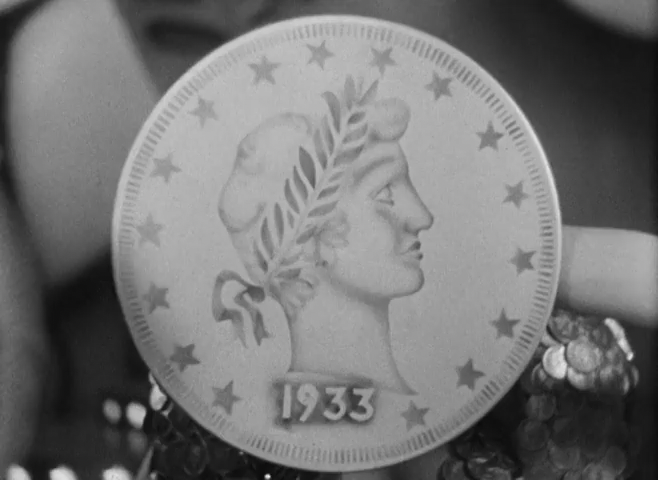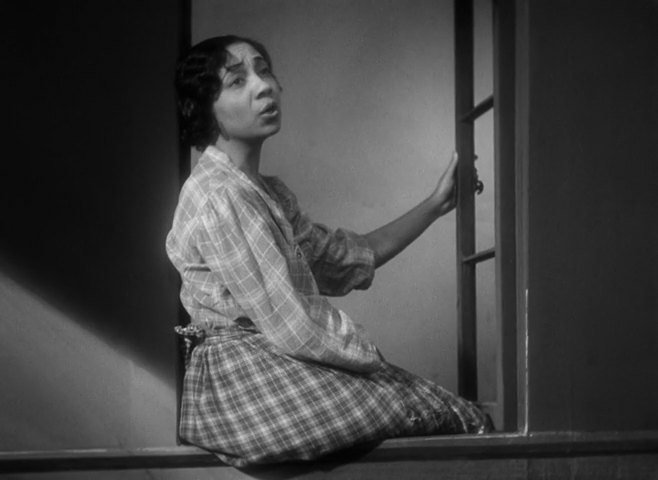Table of Contents
🎪 The pre-code, backstage, Depression-era musical Gold Diggers of 1933 employs a fascinating contrapposto structure where the film's romance plot and the show-within-the-show travel in opposite directions. This creates a narrative in the shape of an X, with interesting implications for how we understand the film's commentary on economics during the Great Depression.
Bookending Images
My high school playwriting teacher once gave us an analytical exercise: take the first and last image of any film and demonstrate how those two images alone tell the story.

The film opens with a close-up on an oversized coin featuring a woman's profile—clearly a prop for the opening musical number "We're in the Money." This number is promptly interrupted when police arrive to repossess everything, including the chorus girls' costumes.

In contrast, the final shot shows Joan Blondell as a street sex worker surrounded by downtrodden people representing Depression-era suffering. Behind them, World War I soldiers appear in silhouette on arched platforms, with the theatre curtain barely visible at the top of the frame.
These bookending images might initially seem disconnected from the main plot, where three "gold diggers" (Polly, Carol, and Trixie) go from starving in a one-room apartment to marrying wealthy husbands. But this contrast is precisely the point.
As a result of the Depression, films in the first half of the 30s favored a hard-hitting, anti-establishment mood... only those antics of the monied class caricaturing them as willful, spoilt, manic and otherwise unsympathetic were accepted by moviegoers... this mood reached its climax with films like Public Enemy and Gold Diggers of 1933.
—John Kobal, Gotta Sing, Gotta Dance p. 93-4
Narrative in the Shape of an X
The film's structure creates a deliberate contrast:
- The romance plot starts with poverty and ends with prosperity
- The show-within-the-show begins with optimistic fantasy ("We're in the Money") and concludes with stark social realism ("Remember My Forgotten Man")
This contrapposto structure (borrowing from classical Greek sculpture, meaning "counterpoise") allows for delayed gratification. After the opening number is interrupted, viewers wait 35 minutes for another full musical sequence, as the film focuses on the struggle to fund the "Forgotten Melody" revue.
When Plot Interrupts Music
Instead of musical numbers interrupting the plot (as we often see in musicals), Gold Diggers of 1933 presents the opposite: the plot interrupts the music. This becomes literal in the film's third section when Lawrence's threat to Brad and Polly's romance delays the "Forgotten Man" finale.
Only when all romantic obstacles are overcome can the film conclude with the "Forgotten Man" number—a sequence that returns us to the economic realities of the Depression.
"Remember My Forgotten Man"
Berkeley's big numbers, generally sung by Dick Powell, Ruby Keeler, or Joan Blondell, comprised one of the Hollywood musical's unique styles, instantly recognizable. Even more basic to these films, however, is the characteristic Warners political reading that shapes them. Gold Diggers of 1933 is suffused with Depression panic. Performing is work; one works to eat. And, lest we forget, the film closes with "Remember My Forgotten Man," a Berkeley phantasmagoria on the socially disinherited war veteran.
—Ethan Mordden, The Hollywood Studios p. 236
The finale serves as more than just a musical spectacle. Despite the romantic plot resolution, the film is "suffused with Depression panic" and closes with "a Berkeley phantasmagoria on the socially disinherited war veteran."

While it's entertaining to watch chorus girls manipulate wealthy men, the film's structure reminds us of the devastating consequences of America's inadequate social safety net. The gold digger and the street sex worker are two sides of the same big, flat, fake coin that opens the film—both strategies women employed to survive economic hardship.
Note: This analysis was inspired by a film teaching exercise where students examine how a film's opening and closing images can reveal its narrative and thematic structure.